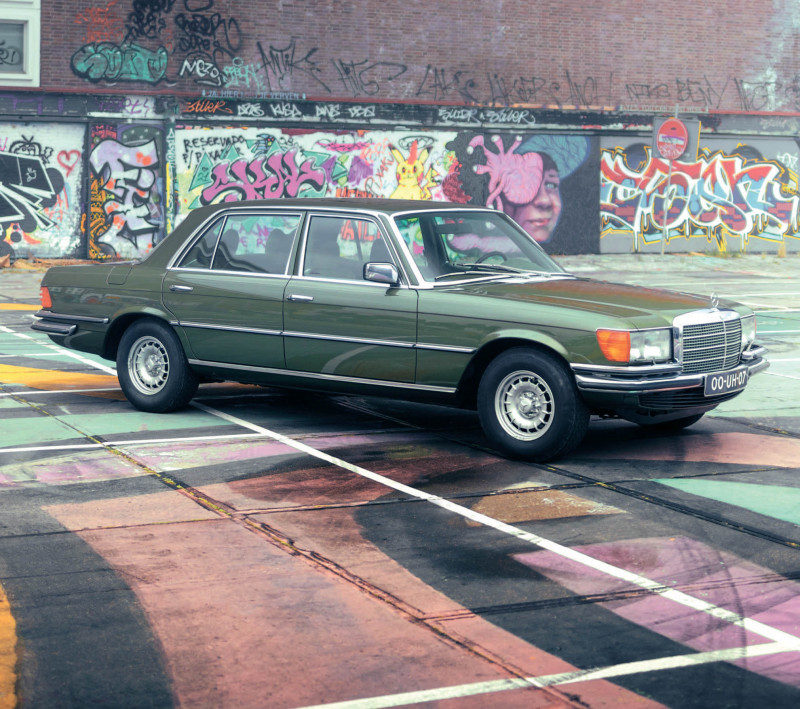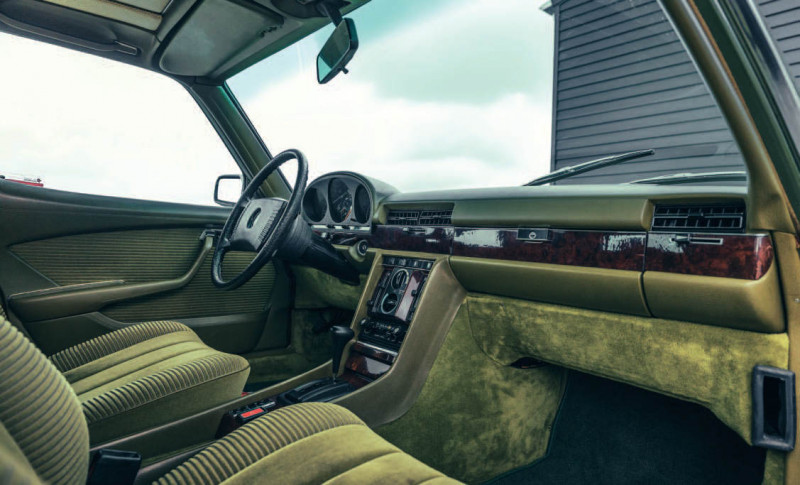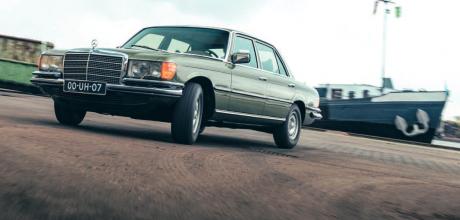1977 Mercedes-Benz 450SEL 6.9 V116
Unblemished in its entirety, this incredibly low-mileage, 1977 450SEL 6.9 is now part of a vast collection in the Netherlands. However, being one of its owner’s favourite cars means it’s no stranger to the open road.
WORLD’S BEST?
Powerhaus
This 6.9 must be among the finest examples in Europe
WORDS ALBERT MENSINGA
IMAGES NOORTJE BLOKLAND
With under 30,000 miles on the clock, this Cypress Green 450SEL 6.9 takes some beating
The high performance 450SEL 6.9 version of the 116-series S-Class looks impressive, but hardly intimidating. On paper, the M100 V8 notes 282bhp at 4,250 revs and 405lb ft of torque at 3,000 revs. Performance-wise, one could easily imagine a 6.9 to be on par with a period Rolls-Royce or Cadillac. But it is not.

Where the American and British competition bet on sheer luxury, the Germans prioritised road holding and high speed cruising, which the 6.9 does in a very majestic way. An added bonus compared to the Caddy and Rolls is its understated looks. A connoisseur would recognise this long-wheelbase S-Class for what it really is, but an amateur car spotter needs to see the 6.9 badge on the bootlid before their jaw drops. And the rear is usually the only thing you will see if you ever encounter a 6.9 on the road.

Last year, Reinier Groenveld invited me to see his Mercedes-Benz collection and his mint looking, Cypress Green (colour code 876G) 6.9 immediately caught my eye. I fell in love with the car when I spotted the matching Moss velour interior which, in 1977 when this car was manufactured, was a more expensive option than full leather.
Reinier has a few 116-series SELs and his 6.9 must be among the fi nest examples in Europe. So experts tell him. Prices for (rare) top notch cars are touching 100,000 euros and decent drivers can be found for a third of that, but expect mega bills when something goes pop. This 1977 example has all the paperwork from day one, and it shows. I could not spot a single flaw on this car.
We need to get inside this 5m-long gem to cover a few miles and find an interesting backdrop for pictures. From where I’m sitting, everything looks untouched and as new, and it feels accordingly. The switches, buttons and handles operate with a typical and familiar meatiness that instils confidence in their ability to operate that way for many years to come. At your command, the 90-degree V8 ticks over with a Bentley-like smoothness. Almost without a sound, the autobox clicks into the first of three long gears. Off we go...
Compared to other 116-series V8s, the 6.9 is somehow even more understated given the performance available, and its general sense of grandeur is far deeper, which makes this saloon pretty much unrivalled. The 6.9 came with four-wheel disc brakes, ABS and four-wheel independent suspension, and no matter whether travelling at walking pace or high speed the 6.9 is always effortless in the way it goes about business.
When extra speed is desired, just the slightest tap of the throttle brings it forth, although Benz engineers decided their 6.8-litre M100 must operate with the absolute minimum of noise. The landscape just whizzes by in near silence, leaving surrounding traffic in awe. What a car.
Cruising with intent
Thanks to the hydro-pneumatic, self-levelling suspension system, our 6.9 absorbs every imperfection in the road surface and still manages to communicate something resembling ‘feel’. Overall, it feels more comfortable and lighter on its feet than non-air damped cars.
Information coming from the Bosch K-Jetronic fed, SOHC (107x95mm), dry-sump (12 litres of oil!) V8 powerplant is another matter. All you will feel is power. I can so imagine this limo touching 140mph on the autobahn and still offering a relaxed ride. The rear wheels (wrapped in 215/70VR14 Michelins) are driven by the ultra-strong W3B 050 three-speed automatic transmission unique to the 6.9. I’ve read stories of turbocharged 6.9’s running fine without any gearbox mod. There’s a standard ZF limited-slip differential, and a 2.65:1 final drive ratio for high speed cruising. Remember the V8’s output figures: there’s no need to pass 2,000 revs but you can pass 4,000 if necessary. Let’s carry on. The cast iron M100 engine is a bigger version of the V8 used in the W100 600 that debuted in 1963, and the W109 300SEL 6.3 of 1968. Before ‘the marriage’, each 6.9 unit was bench tested for 265 minutes, 40 of which were under full load. Until 1972, an in-house designed and built, mechanical fuel injection system was used. Then came mechanically controlled Bosch K-Jetronic fuel injection for the 6.9.
Geek candy are the sodium-filled valves (like in aircraft engines) against hardened valve seats on each aluminium alloy cylinder head. The crankshaft, connecting rods and pistons are forged rather than cast. Thanks to the use of hydraulic valve lifters, no adjustments are required, and special cylinder head gaskets eliminated the need for periodic retorquing of the head bolts. Who said classics are impractical? These top-of-the-line cars had their own assembly line at Daimler-Benz’s plant in Stuttgart and were built to last, as this example shows today in all its magnificence. The 450SEL 6.9 didn’t need much servicing in their first years or 50,000 miles – just the coolant, minor tune-ups, oil changes, and replacement of the air, fuel, oil and power steering filters were enough to keep a 6.9 going. Interested in buying one? Then make sure the service history is as complete as possible.
At the time, a 6.9 could be yours for more than double the price of a full-size Caddy, and Mercedes-Benz raised the retail price over 16 per cent in the five years these automotive icons were made. Even then I don’t think the manufacturer made a reasonable profit on this tour de force flagship car.
Owner’s view
“Back in the day, I considered the 116 S-Class the best and most beautiful car ever made,” begins owner Reinier Groenveld. “When I started my collection, a 450 had to be my first choice. About 30 years ago, I bought a one-owner 450SEL which I drove quite a lot – the odo still only shows 60,000km, though. I lusted for a 6.9, of course. It is the ultimate S-Class. I currently own six 116s – two 6.9s, a 280S, 280SE, 350SEL and a 450SEL. All as new and ready to go.” Reinier also owns a W108 and W126, so is clearly a fan of the ‘Special class’ Mercedes.
“This one-owner 1977 6.9 was offered to me in autumn 2020,” he continues. “A former hospitality industry entrepreneur had passed away, and with 40,000km [around 25,000 miles] and not much use during this century, his car was waiting for me. Relatives often have no clue what to do with a car or a collection, but they feel the need to pass a special and cherished automobile to a similar spirit who’ll take good care of it. Well, that’s me and I became this 6.9’s next custodian.”
The hotel manager bought the 6.9 in 1977 as a gift to himself and added all the options in the book, except the towbar. The car’s service history is worthy of a place in a library, with Mercedes-Benz dealer servicing throughout. “I make no secret of the fact that the cars I paid the most for are also my favourites,” Reinier continues. “Owning such a vast collection makes extra maintenance or any unexpected failure a pain, and I avoid it if I can. Every car is driven at least three or four times a year, so wear should be no problem. A car sitting in a garage is asking for problems. A Mercedes is made to be driven. “Of course, I’ll wait if it’s raining, but on a good day and with enough time on my hands, I’ll take one or two of my cars out for a drive. Maybe even three. My friends often ask to help with the driving, and I fully understand. Maybe when I’m in a wheelchair, I’ll make some calls!”
Reinier (left) with writer Albert Mensinga and 6.9.
Cylinder bore of 107mm is 4mm larger than 6.3's.
The car’s service history is worthy of a place in a library
Just the facts 1977 Mercedes-Benz 450SEL 6.9 (V116)
- ENGINE M100 6,834cc V8
- MAX POWER 282bhp @ 4,250rpm
- MAX TORQUE 405lb ft @ 3,000rpm
- TRANSMISSION 3-speed auto, RWD
- WEIGHT 1,935kg
- 0-62MPH 7.4sec
- TOP SPEED 140mph
- FUEL CONSUMPTION 17.7mpg
- YEARS PRODUCED 1975-1980
All figures from Mercedes-Benz; fuel consumption determined at 3/4 of top speed (not more than 110km.h, 68mph) plus 10 per cent
Moss (code 906) velour and walnut wood trim.
Extra legroom in the rear of this LWB 116-series.
At the time of shooting, the odo read 48,223km.
Pressurised oil system balances oil volume in clever spring struts.
The crankshaft, connecting rods and pistons are forged rather than cast
This 6.9 must be among the finest examples in Europe


